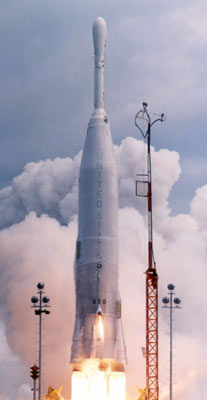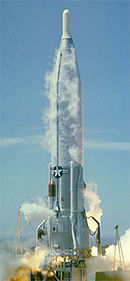Atlas-Able
 An Atlas-Able launching Pioneer P-30 | |
| Has use | |
|---|---|
| Manufacturer | Convair Divsion of General Dynamics |
| Country of origin | United States |
| Size | |
| Height | 28 m (91 ft) |
| Diameter | 3.05 m (10 ft) |
| Payload to Trans-lunar injection | 170 kg (370 lb) |
| Launch history | |
| Status | Retired |
| Launch sites | LC-12, 13 & 14, Cape Canaveral |
| Total launches | 3 |
| Failure(s) | 3 |
| First flight | 26 November 1959 |
| Last flight | 15 December 1960 |
The Atlas-Able was an American expendable launch system derived from the SM-65 Atlas missile. It was a member of the Atlas family of rockets, and was used to launch several Pioneer spacecraft towards the Moon. Of the five Atlas-Able rockets built, two failed during static firings, and the other three failed to reach orbit.[1]
The Atlas-Able was a three-and-a-half-stage rocket, with a stage-and-a-half Atlas missile as the first stage, an Able second stage, and an Altair third stage.[2] The first Atlas-Able used an Atlas C as the first stage,[3] but this exploded during a static fire test on 24 September 1959.[4]
The remaining launches used Atlas D missiles. Launches were conducted from Launch Complexes 12 and 14 at the Cape Canaveral Air Force Station. One launch was planned from Launch Complex 13; this became the second Atlas-Able to be destroyed during a static firing, and hence never launched.[1]
Launches[]
| Number | Miission | Orbit | Launch Site | Outcome |
|---|---|---|---|---|
| 1 | Pioneer P-3 | TLI | LC-14 | Failure |
| The Payload fairing broke up at 45 seconds after liftoff, causing loss of the upper stage and payload.[6] | ||||
| 2 | Pioneer P-30 | TLI | LC-12 | Failure |
| A propellant feed on the second stage had a malfunction.[7] | ||||
| 3 | Pioneer P-31 | TLI | LC-12 | Failure |
| Vibration and/or debris from the Able adapter section ruptured the liquid oxygen tank of Atlas, causing an explosion.[8] | ||||
References[]
- ^ a b Encyclopedia Astronautica - Atlas
- ^ Gunter's Space Page - Atlas-D Able
- ^ Gunter's Space Page - Atlas-C Able
- ^ Space Review, The Pioneer lunar orbiters: a forgotten failure, by Andrew J. LePage, Monday, December 13, 2010
- ^ "Atlas-Able". nextspaceflight.com. Retrieved 2022-02-18.
- ^ "Atlas-D Able | Pioneer P-3". nextspaceflight.com. Retrieved 2022-02-18.
- ^ "Atlas-D Able | Pioneer P-30". nextspaceflight.com. Retrieved 2022-02-18.
- ^ "Atlas-D Able | Pioneer P-31". nextspaceflight.com. Retrieved 2022-02-18.
- Rockets and missiles
- Atlas (rocket family)
- Rocketry stubs
